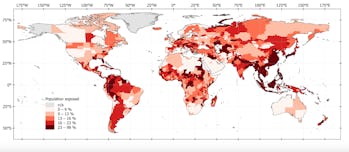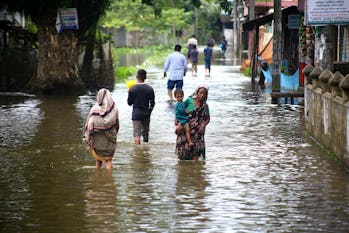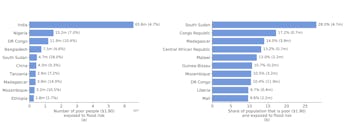1.8 BILLION PEOPLE FACE ONCE-IN-A-CENTURY FLOODING, STUDY REVEALS

A shocking number of people globally are at risk of floods.
Getty
TARA YARLAGADDA
SOBERING IMAGES FROM NORTHEASTERN INDIA and Bangladesh this past month show the toll that historic flooding has caused the region. The extreme weather has killed more than 100 people and left 9.5 million more without food or drinking water.
But these 9.5 million individuals are only a fraction of the global population who are likely to face unprecedented flooding, according to research published Tuesday in the journal Nature Communications. The research reveals a disturbing figure: 1.81 billion people globally are “directly exposed” to one-in-a-hundred-year floods — a risk that will only worsen as global warming increases the likelihood of extreme flooding.
Thomas McDermott, a lecturer in the economics of climate change at the National University of Ireland Galway, tells Inverse the findings are “quite surprising — in fact shocking.” McDermott is not affiliated with the study but authored a Nature Communications article commenting on the research.
WHAT’S NEW — According to the study, 1.8 billion people, or 23 percent of the world’s population, live in areas exposed to a half-foot of water level rise during once-in-a-century flooding. It’s a figure far higher than previous research suggested.
“In other words, considering a global population of 7.9 billion, almost one in four of the world’s people are exposed to significant flood risk,” writes the study’s authors.
“One major surprise from this study is the vast scale of the risk. Flood risks are present in all 188 countries considered in this study,” Jun Rentschler, lead author of the study and Senior Economist at the Office of the Chief Economist for Sustainable Development at the World Bank, tells Inverse.
According to McDermott, the “once-in-a-hundred” phrase is a bit of a misnomer, since it really just refers to anyone living in an area where the risk of flooding is at least one percent in any given year. Still, that percentage shouldn’t be taken lightly. Rentschler says that a 100-year flood has a 22 percent chance of occurring in a 25-year period and a 51 percent chance within 70 years.
“But it is more frequent than the term might suggest because probabilities add up over time,” Rentschler says.
According to the paper, the vast majority of people exposed to floods — 89 percent — live in low-and-middle-income countries, typically in South and East Asia and Africa. While 193 million people face flood risk in higher-income countries like the U.S., far more — some 1.61 billion people — live in lower-and-middle income countries.
“Poor people often lack the resources needed for a fast recovery, which means they can be at risk of devastating long-term impacts on their livelihoods,” Rentschler says.

A figure from the study shows the percentage of the population exposed to flood risk around the world. Rentschler et al
In terms of sheer numbers, 1.24 billion people experiencing flood risk live in South and East Asia. China and India alone account for a third of the global flood risk as 395 million people in China and 390 million in India are exposed to floods. Within countries, people living in certain regions, such as along major river tributaries, face greater flood risk. Roughly two-thirds of people living in the Dhaka region of Bangladesh are at risk of flooding due to their location at the intersection of the Ganges and Brahmaputra Rivers.
While researchers have previously studied flood risk in lower-and-middle income countries, this study uniquely links flood risk with poverty levels across more than 180 countries. The researchers calculate the percentage of people who face flood risk at three different levels of poverty: living under $1.90 per day, less than $3.20 per day, and under $5.50 per day.
“Poverty is a crucial indicator of people’s vulnerability to climate shocks, like floods,” Rentschler says.
A whopping 780 million people living on less than $5.50 per day are exposed to flood risk. Those living in Sub-Saharan Africa are particularly at risk. Of the 170 million people who face flood risk and live in extreme poverty of less than $1.90 per day, 44 percent live in Sub-Saharan Africa.
“We conclude that the number of people living in poverty and under severe flood risk is substantially higher than previously thought,” the study authors write.
HOW THEY DID IT — The scientists drew from population maps and census data, income data from the World Bank’s Global Subnational Atlas of Poverty, and high-quality flood hazard data from the Fathom Global dataset.
This combination of “new data sources” allowed the researchers to analyze flood risk and poverty at a level of “unprecedented” detail according to Rentschler.
The scientists analyzed all three types of flood risk: fluvial, pluvial, and coastal. This affects 7.9 billion people in 188 countries around the world. Fluvial flood risks occur in low-lying river regions while pluvial flooding occurs in mountainous regions with poor drainage systems and a high risk of flash floods.

People wade through floodwaters in Companiganj, Bangladesh on June 26, 2022.
TARA YARLAGADDA
SOBERING IMAGES FROM NORTHEASTERN INDIA and Bangladesh this past month show the toll that historic flooding has caused the region. The extreme weather has killed more than 100 people and left 9.5 million more without food or drinking water.
But these 9.5 million individuals are only a fraction of the global population who are likely to face unprecedented flooding, according to research published Tuesday in the journal Nature Communications. The research reveals a disturbing figure: 1.81 billion people globally are “directly exposed” to one-in-a-hundred-year floods — a risk that will only worsen as global warming increases the likelihood of extreme flooding.
Thomas McDermott, a lecturer in the economics of climate change at the National University of Ireland Galway, tells Inverse the findings are “quite surprising — in fact shocking.” McDermott is not affiliated with the study but authored a Nature Communications article commenting on the research.
WHAT’S NEW — According to the study, 1.8 billion people, or 23 percent of the world’s population, live in areas exposed to a half-foot of water level rise during once-in-a-century flooding. It’s a figure far higher than previous research suggested.
“In other words, considering a global population of 7.9 billion, almost one in four of the world’s people are exposed to significant flood risk,” writes the study’s authors.
“One major surprise from this study is the vast scale of the risk. Flood risks are present in all 188 countries considered in this study,” Jun Rentschler, lead author of the study and Senior Economist at the Office of the Chief Economist for Sustainable Development at the World Bank, tells Inverse.
According to McDermott, the “once-in-a-hundred” phrase is a bit of a misnomer, since it really just refers to anyone living in an area where the risk of flooding is at least one percent in any given year. Still, that percentage shouldn’t be taken lightly. Rentschler says that a 100-year flood has a 22 percent chance of occurring in a 25-year period and a 51 percent chance within 70 years.
“But it is more frequent than the term might suggest because probabilities add up over time,” Rentschler says.
According to the paper, the vast majority of people exposed to floods — 89 percent — live in low-and-middle-income countries, typically in South and East Asia and Africa. While 193 million people face flood risk in higher-income countries like the U.S., far more — some 1.61 billion people — live in lower-and-middle income countries.
“Poor people often lack the resources needed for a fast recovery, which means they can be at risk of devastating long-term impacts on their livelihoods,” Rentschler says.

A figure from the study shows the percentage of the population exposed to flood risk around the world. Rentschler et al
In terms of sheer numbers, 1.24 billion people experiencing flood risk live in South and East Asia. China and India alone account for a third of the global flood risk as 395 million people in China and 390 million in India are exposed to floods. Within countries, people living in certain regions, such as along major river tributaries, face greater flood risk. Roughly two-thirds of people living in the Dhaka region of Bangladesh are at risk of flooding due to their location at the intersection of the Ganges and Brahmaputra Rivers.
While researchers have previously studied flood risk in lower-and-middle income countries, this study uniquely links flood risk with poverty levels across more than 180 countries. The researchers calculate the percentage of people who face flood risk at three different levels of poverty: living under $1.90 per day, less than $3.20 per day, and under $5.50 per day.
“Poverty is a crucial indicator of people’s vulnerability to climate shocks, like floods,” Rentschler says.
A whopping 780 million people living on less than $5.50 per day are exposed to flood risk. Those living in Sub-Saharan Africa are particularly at risk. Of the 170 million people who face flood risk and live in extreme poverty of less than $1.90 per day, 44 percent live in Sub-Saharan Africa.
“We conclude that the number of people living in poverty and under severe flood risk is substantially higher than previously thought,” the study authors write.
HOW THEY DID IT — The scientists drew from population maps and census data, income data from the World Bank’s Global Subnational Atlas of Poverty, and high-quality flood hazard data from the Fathom Global dataset.
This combination of “new data sources” allowed the researchers to analyze flood risk and poverty at a level of “unprecedented” detail according to Rentschler.
The scientists analyzed all three types of flood risk: fluvial, pluvial, and coastal. This affects 7.9 billion people in 188 countries around the world. Fluvial flood risks occur in low-lying river regions while pluvial flooding occurs in mountainous regions with poor drainage systems and a high risk of flash floods.

People wade through floodwaters in Companiganj, Bangladesh on June 26, 2022.
Getty
WHY IT MATTERS —People living in low-and-middle-income countries are most at risk of flooding, but the researchers are clear to emphasize that flooding can and does happen in nearly every nation. Only nine percent of subnational regions, or areas within countries, covered in the study face flood risks to less than one percent of their population. Roughly 12.5 percent of the U.S. population faces high flood risk according to supplementary data in the study.
“Recent disastrous floods in countries as diverse as Nigeria, Bangladesh, Vietnam, the United States, and the United Kingdom illustrate that the threat is a global reality,” conclude the researchers.
Flood risk exacts not only a human toll but also an economic one. According to the research, areas with “significant flood risks” are involved in $9.8 trillion worth of economic activity, which extreme flood events threaten to disrupt.
DIGGING INTO THE DETAILS — Higher-income countries often face significant financial losses from flooding, but they are often able to adapt to or lessen the damage from flooding in ways that poorer nations cannot. Focusing on flood exposure or economic losses alone doesn’t paint a “full picture” of true flood risk and risks biasing research toward higher-income nations, according to the research.
“The same flood event may be a mere inconvenience for wealthy people, but be absolutely devastating for poorer people,” Rentschler says.
For example, the country with the greatest flood risk exposure is the Netherlands. Nearly 60 percent of the country’s population lives in areas facing more than five inches of flooding, but the study says that the Dutch have the world’s most “comprehensive flood protection systems” that can protect against once-in-a-thousand-year extreme flood events.
On the other hand, a country like Vietnam may not have the means to adapt to climate change as successfully. Despite building dike systems across the country, Vietnam can still only “protect against 1-in-30-year coastal flooding, and would be overwhelmed by more severe events” according to the research.
The paper presents a remarkable overview of the global flood risks and how they intersect with poverty, but there’s still more data that needs to be gathered, experts suggest, especially on the flood risks facing poorer individuals within higher-income nations. McDermott says that “those on lower incomes tend to suffer worse consequences when disasters strike.”

A figure shows the intersection of poverty and flood risk. Rentschler et al
WHAT’S NEXT — The researchers have unveiled their findings, but it will be up to policymakers to translate the science into actionable measures to protect these 1.8 billion people around the world. Rentschler says “poor planning” such as the lack of drainage systems and development in high-risk areas increases the likelihood of flood damage.
“Conserving or restoring natural flood protection systems – such as wetlands and uninhabited flood plains — can be cost-effective solutions to reduce risks,” Rentschler says.
McDermott outlines three crucial paths forward for policymakers.
The first step: Curb greenhouse gas emissions, which are driving climate change and increasing the risk of severe flooding. We must take action on climate change “so that these risks do not get considerably worse in the coming decades,” McDermott says.
Second, the study’s findings imply that we need to invest more in disaster preparedness. This could involve investing in green infrastructure, emergency warning systems and flood defenses, as well as generally building up the capacity of communities to cope with disasters.
Finally, we should avoid building in areas where flood risk is highest, according to McDermott. The cost of not taking action is too high to consider.
“Flooding is by far the most pervasive climate hazard around the world, with floods displacing tens of millions of people from their homes each year, and causing hundreds of billions of US dollars in direct damages,” McDermott says.
WHY IT MATTERS —People living in low-and-middle-income countries are most at risk of flooding, but the researchers are clear to emphasize that flooding can and does happen in nearly every nation. Only nine percent of subnational regions, or areas within countries, covered in the study face flood risks to less than one percent of their population. Roughly 12.5 percent of the U.S. population faces high flood risk according to supplementary data in the study.
“Recent disastrous floods in countries as diverse as Nigeria, Bangladesh, Vietnam, the United States, and the United Kingdom illustrate that the threat is a global reality,” conclude the researchers.
Flood risk exacts not only a human toll but also an economic one. According to the research, areas with “significant flood risks” are involved in $9.8 trillion worth of economic activity, which extreme flood events threaten to disrupt.
DIGGING INTO THE DETAILS — Higher-income countries often face significant financial losses from flooding, but they are often able to adapt to or lessen the damage from flooding in ways that poorer nations cannot. Focusing on flood exposure or economic losses alone doesn’t paint a “full picture” of true flood risk and risks biasing research toward higher-income nations, according to the research.
“The same flood event may be a mere inconvenience for wealthy people, but be absolutely devastating for poorer people,” Rentschler says.
For example, the country with the greatest flood risk exposure is the Netherlands. Nearly 60 percent of the country’s population lives in areas facing more than five inches of flooding, but the study says that the Dutch have the world’s most “comprehensive flood protection systems” that can protect against once-in-a-thousand-year extreme flood events.
On the other hand, a country like Vietnam may not have the means to adapt to climate change as successfully. Despite building dike systems across the country, Vietnam can still only “protect against 1-in-30-year coastal flooding, and would be overwhelmed by more severe events” according to the research.
The paper presents a remarkable overview of the global flood risks and how they intersect with poverty, but there’s still more data that needs to be gathered, experts suggest, especially on the flood risks facing poorer individuals within higher-income nations. McDermott says that “those on lower incomes tend to suffer worse consequences when disasters strike.”

A figure shows the intersection of poverty and flood risk. Rentschler et al
WHAT’S NEXT — The researchers have unveiled their findings, but it will be up to policymakers to translate the science into actionable measures to protect these 1.8 billion people around the world. Rentschler says “poor planning” such as the lack of drainage systems and development in high-risk areas increases the likelihood of flood damage.
“Conserving or restoring natural flood protection systems – such as wetlands and uninhabited flood plains — can be cost-effective solutions to reduce risks,” Rentschler says.
McDermott outlines three crucial paths forward for policymakers.
The first step: Curb greenhouse gas emissions, which are driving climate change and increasing the risk of severe flooding. We must take action on climate change “so that these risks do not get considerably worse in the coming decades,” McDermott says.
Second, the study’s findings imply that we need to invest more in disaster preparedness. This could involve investing in green infrastructure, emergency warning systems and flood defenses, as well as generally building up the capacity of communities to cope with disasters.
Finally, we should avoid building in areas where flood risk is highest, according to McDermott. The cost of not taking action is too high to consider.
“Flooding is by far the most pervasive climate hazard around the world, with floods displacing tens of millions of people from their homes each year, and causing hundreds of billions of US dollars in direct damages,” McDermott says.
No comments:
Post a Comment